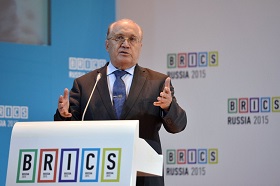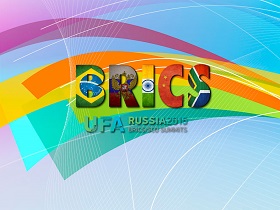October 2015 saw the final major event included in the official Plan for the Russian Federation’s Presidency in BRICS in 2015–2016 — the BRICS Global University Summit (GUS) — concluded in Moscow. The forum brought together more than 300 representatives of the academic and research community of the five nations. Anyway, in terms of the number of participants in the University Summit itself and the IX Conference of the Russian Association of International Studies (RAIS) held in parallel with the BRICS GUS (one of the sections of the conference, organized under the auspices of the National Committee on BRICS Research, is an important element of the Plan) the event brought together at least twice as many attendees as before!
October 2015 saw the final major event included in the official Plan for the Russian Federation’s Presidency in BRICS in 2015–2016 — the BRICS Global University Summit (GUS) — concluded in Moscow. The forum brought together more than 300 representatives of the academic and research community of the five nations [1]. Anyway, in terms of the number of participants in the University Summit itself and the IX Conference of the Russian Association of International Studies (RAIS) held in parallel with the BRICS GUS (one of the sections of the conference, organized under the auspices of the National Committee on BRICS Research, is an important element of the Plan) the event brought together at least twice as many attendees as before! To show the sheer scope of the forum we should quote Anatoly Torkunov, Rector of MGIMO University, who noted in his welcome remarks that “18 Brazilian universities, 17 Indian universities, 13 Chinese universities and eight South African universities were represented at the event,” and Russia, during its BRICS presidency this year, “enjoyed the broadest representation at the summit,” with participants from 69 educational institutions. The opening of the BRICS GUS that also celebrated the 70th anniversary of the United Nations was held at the Bolshoi Theatre, whereas subsequent discussions were organized at MGIMO in partnership with three more leading universities of the country — Lomonosov Moscow State University, Peoples’ Friendship University of Russia, and the National University of Science and Technology MISiS. Anyway, given the extended coverage of the event by domestic and foreign media we will attempt to focus on the integrated impact of the forum within the framework of Russia’s BRICS presidency.
Equal status of Track II
The BRICS GUS became the final event within the framework of Russia’s BRICS presidency that showed the degree of importance that Russia attaches to not only the format of the engagement within the bloc, but also the involvement of all social groups in the collaboration process, development of new dimensions of cooperation, and testing of new ideas and formats. Anyway, it was Russia that originally proposed most of the current engagement formats within BRICS. Back in 2008, when the first full-scale BRIC meeting at the level of ministers was held, Russia played host to the first Academic Forum of the four, and then five nations, which started the tradition of regular meetings in this format. Also in 2008, the first civil, youth, parliamentary, and trade union forums were organized on Russia’s initiative. Since the Durban Summit, the BRICS Think Tank Council (BTTC) and the BRICS Business Council have been having meetings on a regular basis. Incidentally, the two years of the BTTC operation resulted in the adoption of the Long-Term Strategy for BRICS by the heads of the five nations at the Ufa Summit.
Following each meeting, its participants approved a series of recommendations presented to the official track. Specifically, after the Civil Forum, the co-chair of the Civil Forum was invited to the meeting of the BRICS Sherpas preceding the summit in order to discuss the proposals of the broad community submitted to the five heads of state. During that meeting, Russian BRICS sherpa Sergei Ryabkov, the country’s deputy foreign minister, spoke highly of the efforts by civil society, whereas the other sherpas also pledged to continue working in that dimension, including India, which is getting ready to take over the BRICS presidency from Russia.
The parliamentary forum was also praised by its participants, although the BRICS partners were very cautious about the initiative of Russian MPs to establish the BRICS Parliamentary Assembly. Despite the fact that our BRICS partners have not yet had a serious discussion of this format for engagement, MPs proved to discover lots of areas of mutual interest within the current international agenda.
What academicians talk about
But let’s get back to the recent University Summit. Back at the planning stage, it was clear that the essence of the event is to ensure the continuity of the topics under discussion — the said challenges were included and addressed within both the official track and the entire range of public diplomacy events, although the summit naturally focused on challenges to education and transformation of the role of BRICS universities in the modern world. The BRICS Global University Summit report paved the way for constructive discussions. The educational projects initiated within the framework of BRICS, primarily the BRICS Network University, became the most discussed topics. In this context, we should once again emphasize the role of MGIMO University: before the initiative was first voiced at the ministerial level and then submitted to the country leaders, the idea was originally proposed by Yu. Dubinin, Professor at the Department of International Relations and Foreign Policy of Russia at the MGIMO University, at a meeting of the National Committee on BRICS Research. The idea proved to be appealing and was approved by the BRICS partners at a regular BTTC meeting and then supported by the Ministry of Foreign Affairs of Russia and the Ministry of Education, and only at a later stage became a public domain, when the key areas for inter-university engagement, which are of priority importance for the five countries, were elaborated. In a similar way, the initiatives for BRICS universities to evolve into leading international research and educational institutions and proposals concerning the ranking of educational institutions, including the development of an alternative rating system, successfully passed all the stages of expert discussions. All of these initiatives are included in the Long-Term Strategy for BRICS approved by the heads of state.
The idea put forth by V. Sadovnichiy, Rector of Lomonosov Moscow State University, concerning the creation of the Association of BRICS Research and Educational Center, which was voiced at the BRICS GUS, appeared to be equally exciting. A week prior to the summit, China played host to a meeting of heads of BRICS universities, who signed a document on the League of BRICS Universities.
The discussions within the framework of the BRICS GUS were not limited to educational issues. The summit addressed a broad range of challenges — from “geopolitical engineering” and combat against terrorism and extremism to the engagement in industrial and innovation policies, joint IT developments, shipbuilding and aircraft industry, robotics industry, additive technologies and biotechnologies, which will facilitate the development of specific projects in line with the Strategy for BRICS Economic Partnership adopted at the Ufa Summit. Discussions also focused on the New Development Bank (NDB), including from the perspective of the implementation of infrastructure projects in the five countries.
Quo vadis
However, it seems focus should be shifted from specific areas for cooperation within BRICS towards its philosophical and existential foundations and prospects of further cooperation. Within the framework of the plenary session of the RAIS and GUS, which centered on the role of BRICS in the transformation of the global order, S. Ryabkov, Russia’s BRICS Sherpa, called against “mystifying our own product.” His appeal was associated with the fact that many observers note that the five partners have different interests. Nevertheless, it is the pragmatic approach that determines the interest of all of the BRICS member states in continuing their engagement within the bloc. Even though this collaboration may progress slower than the participants in this process wish it did, it does not mean the BRICS format is fragile, but suggests that the partners should be making more effort and seek compromises. Indeed, each of the BRICS member state has its own interests, and none will confront any power players in order to stand up for a partner. However, it is that pragmatic interest that determines the common commitment to prevent the practice of unilateral military interventions and economic sanctions, as well as extraterritorial enforcement of national law in order to punish any member of the international community if that member should disagree with the majority. At the same time, BRICS continues to emphasize that its key principle is not to direct its activity against anyone, maintain transparency and commit to a peaceful reform of the world order that would suit all of the members of the global community.
According to Minister of Foreign Affairs of Russia S. Lavrov, the absence of severe internal discipline is what distinguishes BRICS from other blocs, because BRICS is a format of collaboration based on equality and mutual respect, on civilizational and cultural diversity and democratic principles as the foundations of the emerging world order. The high level of identity of the five nations amid ongoing globalization processes, similarity of their philosophical attitudes concerning the profound significance of traditions and culture, rejection of stereotypical coarse unification of these nations with the use of the same “mold” — these are the factors that identify the deep level of engagement within BRICS.
1. Track II is meant here, because the Government’s Plan incorporates a series of ministerial, departmental, and expert meetings at various levels — from the struggle against corruption and meeting of the anti-drug working group to meetings of health ministers, the energy cluster, tax agencies, and many more — in excess of 100 events within less than a year. The most important upcoming event is the informal summit of the BRICS leaders on the sidelines of the G20 Leaders Summit in Turkey slated for 15–16 November, 2015.






